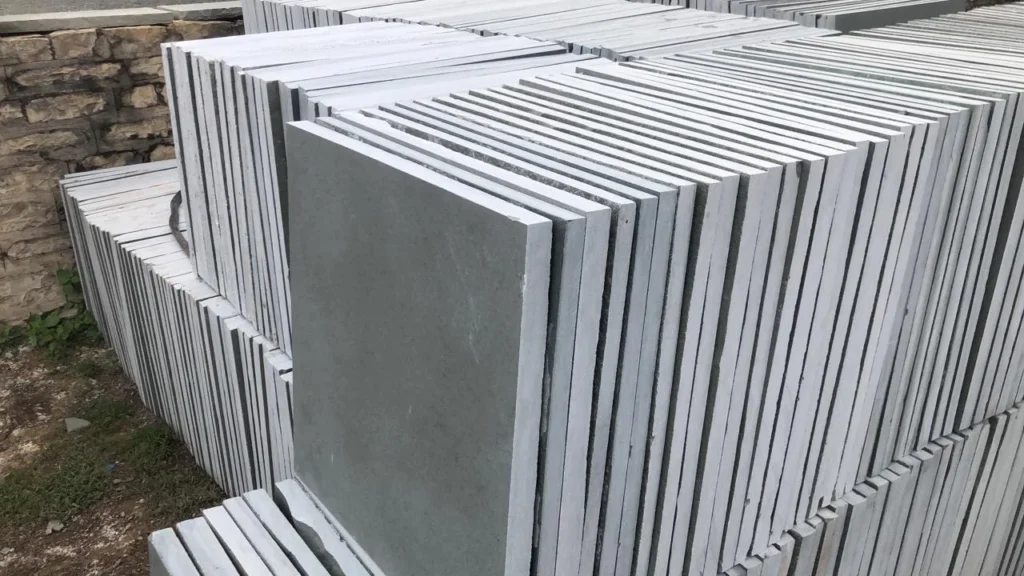Per sq.ft. weight of kota stone depends on kota stone thickness if kota pathar thickness has weight following.blue kota stone has below weight if brown colour kota stone has different weight.kota pathar weight belong to polished & rough stone.
Per sq.ft weight of Kota stone
- 12mm to 16mm than per sq. ft weight – 3.50kg/-sq.ft.
- 18-24mm thickness than weight- 4.50kg/-sq.ft.
- thickness- 25-32mm weight – 6.00kg/-sq.ft.
- 30-35mm thickness- weight- 7kg/-sq.ft.
- 40-45mm thickness weight – 9kg/-sq.ft.
- 45-50mm thickness- weight – 11kg/-sq.ft.
- 22”x22” thickness- 18-24mm weight- 17kg./-pcs.
- 23’x23” thickness – 18-24mm weight – 19.50kg/-pcs.
- 22”x22” thickness- 25-32mm weight – 22kg/-pcs.
- 23”x23” thickness- 25-32mm weight – 25kg/-pcs.

Kota Stone Strength Per Square Foot
Kota stone is a type of fine-grained limestone that hails from the Kota region in India. It’s extensively used for flooring due to its elegance, durability, and natural beauty. When choosing a stone for flooring or construction purposes, strength is one of the critical parameters to consider, as it determines the stone’s resistance to wear and tear, load-bearing capacity, and longevity. Here, we will delve into the strength of Kota stone per square foot.
1. Compressive Strength: The compressive strength of a material is the force it can withstand without being crushed. For Kota stone, the average compressive strength is approximately 90-120 N/mm^2. This is fairly high and signifies that the stone can withstand a considerable amount of weight without cracking or breaking.
2. Flexural Strength: Flexural strength represents the amount of bending a material can endure without breaking. The flexural strength of Kota stone ranges from 13-20 N/mm^2. This property makes it an excellent choice for flooring, even in areas with high foot traffic, as it won’t easily crack under pressure.
3. Density: The density of Kota stone is around 2.5 to 2.7 gm/cc. A higher density often translates to greater strength and durability. The dense nature of Kota stone means it offers resistance to wear, making it suitable for areas like walkways and corridors.
4. Porosity: Kota stone exhibits a low porosity, which means it has fewer tiny spaces or pores. This low porosity gives the stone higher strength and also makes it less vulnerable to staining or water absorption.
5. Abrasion Resistance: A material’s resistance to being worn down is termed its abrasion resistance. Kota stone’s resistance to abrasion is commendable, and it maintains its sheen and surface texture even with prolonged use.
Applications based on Strength: Due to its impressive strength per square foot, Kota stone finds its use in various applications:
Residential Flooring: Its durability combined with aesthetic appeal makes it a preferred choice for homes.
Commercial Spaces: Its ability to endure heavy foot traffic makes it apt for commercial spaces like malls, offices, and hotels.
Staircases and Pathways: The anti-skid nature and strength of Kota stone make it ideal for staircases and pathways.
Industrial Areas: Because of its strength, Kota stone can be used in industries where the flooring needs to withstand heavy machinery and traffic.
Conclusion: Kota stone’s strength per square foot is a testament to its durability and longevity. It’s not just about its appealing natural look; the physical properties of this limestone make it a reliable choice for various construction and decorative applications. Proper installation and regular maintenance can further enhance its lifespan, making it a worthy investment for both residential and commercial spaces.
